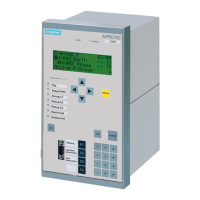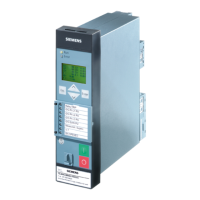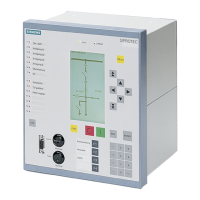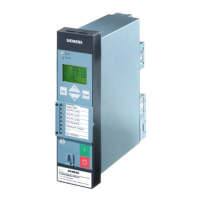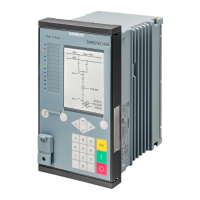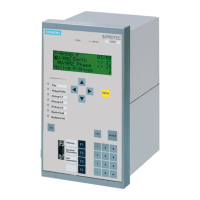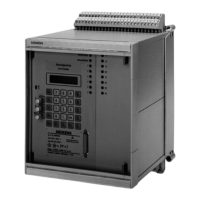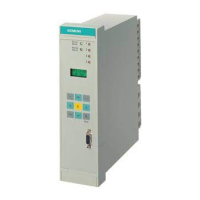Addresses 7202 bef.1.Cy:50-2, 7214 bef.2.Cy:50-2 and 7203 bef.1.Cy:50N-2 und 7215 bef.
2.Cy:50N-2 are set to instant. T=0 to enable the elements after the first reclosing. Addresses 7226 bef.
3.Cy:50-2 and 7227 bef.3.Cy:50N-2, however, are set to blocked T=∞, to ensure that elements 50-2
and 50N-2 are blocked when the second reclosing applies. The back-up elements, e.g. 50-1 and 50N-1, must
obviously not be blocked (addresses 7200, 7201, 7212, 7213, 7224 and 7225).
The blocking applies only after reclosure in accordance with the set address. Hence, it is possible to specify
again other conditions for a third reclosure.
The blocking conditions are also valid for the zone sequence coordination, provided it is available and acti-
vated (address 7140, see also margin heading "Zone Sequencing").
Zone Sequencing / Fuse Saving Scheme
It is the task of the zone sequence coordination to harmonize the automatic reclosure function of this device
with that of another device that forms part of the same power system. It is a complementary function to the
automatic reclosure function and allows, for example, to perform group reclosing operations in radial systems.
In case of multiple reclosures, groups may also be in nested arrangement and further high-voltage fuses can
be overgraded or undergraded.
Zone sequencing works by blocking certain protection functions depending on the reclosing cycle. This is
implemented by the protection elements control (see margin heading "Controlling Protection Elements").
As a special feature, changing from one reclosing cycle to the next is possible without trip command only via
pickup/dropout of 50-1 or 50N-1.
The following figure shows an example of a group reclosure at feeder 3. It is assumed that reclosure is
performed twice.
With fault F1 on feeder 5, protection devices in the infeed and on feeder 3 pick up. The time delay of the 50-2
element at protecting feeder 3 is set in such a way that the feeder 3 circuit breaker will clear the fault before
the fuse at feeder 5 is damaged. If the fault is cleared, all functions are reset after the restraint time has
expired and the fault is terminated. The fuse has therefore also been protected.
If the fault continues to exist, a second reclosing cycle is performed in the same way.
High speed element 50-2 is now blocked at relay protecting Feeder 3. If the fault still remains, only the 50-1
element continues to be active in Feeder 3 which, however, overgrades the fuse with a time delay of 0.4 s.
After the fuse operated to clear the fault, the series-connected devices drop out. If the fuse fails to clear the
fault, then the 50-1 element protecting Feeder 3 will operate as backup protection.
The 50-2 element at the busbar relay is set with a delay of 0.4 seconds, since it supposed to trip the 50-2
elements and the fuses as well. For the second reclosing, the 50-2 element also has to be blocked to give pref-
erence to the feeder relay (50-1 element with 0.4 s). For this purpose, the device has to "know" that two
reclosing attempts have already been performed.
In this device, zone sequence coordination must be switched on: When pickup of 50-1 or 50N-1 drops out,
zone sequence coordination provokes that the reclosing attempts are counted as well. If the fault still persists
after the second reclosure, the 50-1 element, which is set to 0.9 seconds, would serve as backup protection.
For the busbar fault F2, the 50-2 element at the bus would have cleared the fault in 0.4 seconds. Zone
sequencing enables the user to set a relatively short time period for the 50-2 elements. The 50-1 element is
only used as backup protection. If zone sequencing is not applied, the 50-1 element is to be used only with its
relatively long time period (0.9 s).
2.11.5
Functions
2.11 Automatic Reclosing System 79
SIPROTEC 4, 7SJ61, Manual 155
C53000-G1140-C210-6, Edition 05.2016
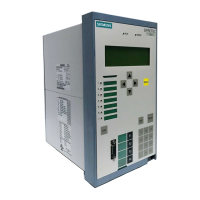
